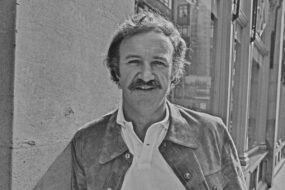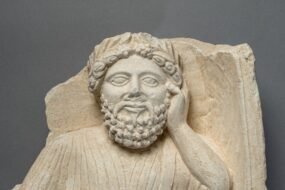Kurt Pantzer Sr. was the type of person whose accomplishments were almost vast enough to defy quantification.
He served as a U.S. Army infantry captain from 1917 to 1919. He returned to his native Indianapolis as an attorney and became a partner in the Barnes, Hickam, Pantzer and Boyd law firm. The U.S. Supreme Court appointed him as special master in a lawsuit over water rights in the Delaware River. He cultivated such vibrant grounds at his Meridian Street home that it appeared on the Park School Garden Tour. He chaired Richard Nixon’s Finance Committee for Indiana before Nixon accepted the 1968 Republican presidential nomination.
But perhaps his most lasting legacy stemmed from a hobby that cemented Pantzer as an art world darling: amassing one of the largest U.S. collections of works by the English Romantic painter J.M.W. Turner. To top it off, he ferreted out related letters, manuscripts and portraits that he dubbed “Turnerabilia.”
He began to move the collection to the Indianapolis Museum of Art at Newfields in 1972 and bequeathed most of it to the institution after his death in 1979 at age 86.
“We’re just so lucky that the timing was right with Kurt Pantzer in Indianapolis obsessively collecting these things,” said Anna Stein, Newfields’ associate curator of works on paper. “We ended up with one of the most spectacular collections anywhere.”
On the 250th anniversary of Turner’s birth, the art world is recognizing the British artist who helped elevate watercolor and landscapes as serious and even sought-after pieces. And thanks in large part to Pantzer, Newfields is joining the celebration with its exhibit “Luminous Horizons: Celebrating the Legacy of J.M.W. Turner.”
‘A brush stroke (Turner) made 200 years ago still feels fresh’
Turner’s works often depict almost otherworldly-feeling scenes of nature and industrialization, incorporating impeccable detail in buildings, ships, trees and miniscule people who sometimes populate the foreground.
The precision is thanks to Turner’s early studies as an architectural draftsman, Stein said. Born in 1775 in London, Joseph Mallord William Turner exhibited artistic prowess at a young age and attended the British Royal Academy to develop his talent. He went on to excel in watercolors and landscapes, which the turn-of-the-19th-century art establishment didn’t value as much as they did paintings of historical subjects.
“For a long time, (watercolor) was just considered part of a drawing tradition — what you did as you did your preparatory work to prepare for your large canvas,” Stein said.
But Turner, who also created oils and engravings before his death in 1851, ended up elevating watercolors and landscapes to a serious art form with contemporaries like John Constable and Caspar David Friedrich. Turner also inspired subsequent generations of painters with his expressive use of light, Stein said.
The artist often loaded up supplies and then trekked to majestic sites, like his 1816 visit to the 70-foot waterfall at England’s river Tees depicted in “Fall of the Tees, Yorkshire.” Dwarfed by the mighty cliffs and rushing water is a tiny figure of an artist sketching — perhaps Turner himself.
He also cherished new pigments, which have proven unstable over time and faded, Stein said. One of his best preserved works is “Rosslyn Castle,” which captures the historic chapel that rose to fame more recently in the book-turned-movie “The Da Vinci Code.” Scottish author Sir Walter Scott commissioned the piece and hung it behind a curtain to keep out the light. As a result, the colors from the watercolor remain more vibrant.
But Turner’s use of color is only one reason his art remains intriguing.
“I think there is a freshness to them that has lasted. Even the ones that have faded a little bit, the gestural qualities seem to just last through the ages,” Stein said. “A brush stroke he made 200 years ago still feels fresh to my eyes. There’s a luminosity that still speaks.”
Such strokes delighted Pantzer for most of his life.
How Pantzer fell in love with Turner
The Indianapolis art collector traced his love of Turner to a single moment in 1914 — the day when the Harvard University undergraduate sat in a lecture about the artist. In 1937, he bought “The Prince of Orange Landing at Torbay,” thought to be his first Turner purchase, according to an essay by Marty Krause, the Indianapolis Museum of Art’s former longtime curator of prints and drawings, in “A Passionate Eye and a Public Spirit: Kurt F. Pantzer and the J.M.W. Turner Collection.”
Pantzer was prepared to sacrifice for his dream.
“As you know, I always swore I should purchase a Turner when I had made my first $100,000.00,” Pantzer wrote in a letter to his sister-in-law. “I was gratified to find it did not require the anticipated $20,000.00 to obtain the painting.”
Decades later, the collector learned that the watercolor was not part of the authoritative listing of the artist’s work in that medium, Krause wrote. Neither were several other pieces Pantzer had acquired in 1938 from John Anderson Jr., an art collector and dealer who claimed to find thousands of never-before-known drawings by Turner with hidden signatures.
Nonetheless, the Indianapolis collector did successfully acquire original Turners throughout his life. All in all, Pantzer’s keen eye and relationships netted him 38 of the artist’s watercolors, 3,000 engravings and seven life portraits, according to Newfields’ collection overview. In addition, Pantzer collected Japanese prints and Impressionist paintings.
Along with the art, Pantzer stacked the shelves from floor to ceiling in his upstairs study with rare books on the artist, wills and sales catalogues, Krause wrote. The collector sought letters, manuscripts and research by Turner’s predecessors, contemporaries, champions and even an art student who could masterfully copy his pieces. What’s more, Pantzer’s own archivist organized the documents meticulously, said Anastasia Karel, interim director of Newfields’ library and archives.
“If you’re a dedicated collector, this is a model to aspire to,” Karel said.
In 1972, Pantzer moved the artworks to the museum, where it was shown in the new Clowes Pavilion. He bequeathed most of his Turner collection to the institution, which has also collected its own works by the artist, Stein said. “Luminous Horizons” includes 17 Turner watercolors.
After spending decades with his beloved pieces, Pantzer wryly observed that living apart from them required some emotional adjustment, Krause notes.
“I have suffered from a cold here in our home,” the collector wrote to an art historian around the time of the move. “The condition was doubtless brought about by the fact we transferred our Turner collection to the new Art Museum where it now hangs in much greater splendor.”
If you go
- “Luminous Horizons: Celebrating the Legacy of J.M.W. Turner”: Through Jan. 4, 2026. 4000 Michigan Road. Included with general admission and free for members.
- Curator talk with Marty Krause: 1 p.m. Oct. 4. DeBoest Lecture Hall at Newfields. $15 public. Free for members. Advance tickets required: discovernewfields.org
- Visit Newfields’ archives: View the manuscripts, research and documents Pantzer collected in relation to his Turner watercolors by emailing archives@discovernewfields.org to set up an appointment. Learn more at discovernewfields.org/archives
This Indy newsletter has the best shows, art and eats
Contact IndyStar reporter Domenica Bongiovanni at 317-444-7339 or d.bongiovanni@indystar.com. Sign up here for the newsletter she curates about things to do and ways to explore Indianapolis. Find her on Facebook, Instagram or Twitter: @domenicareports.









